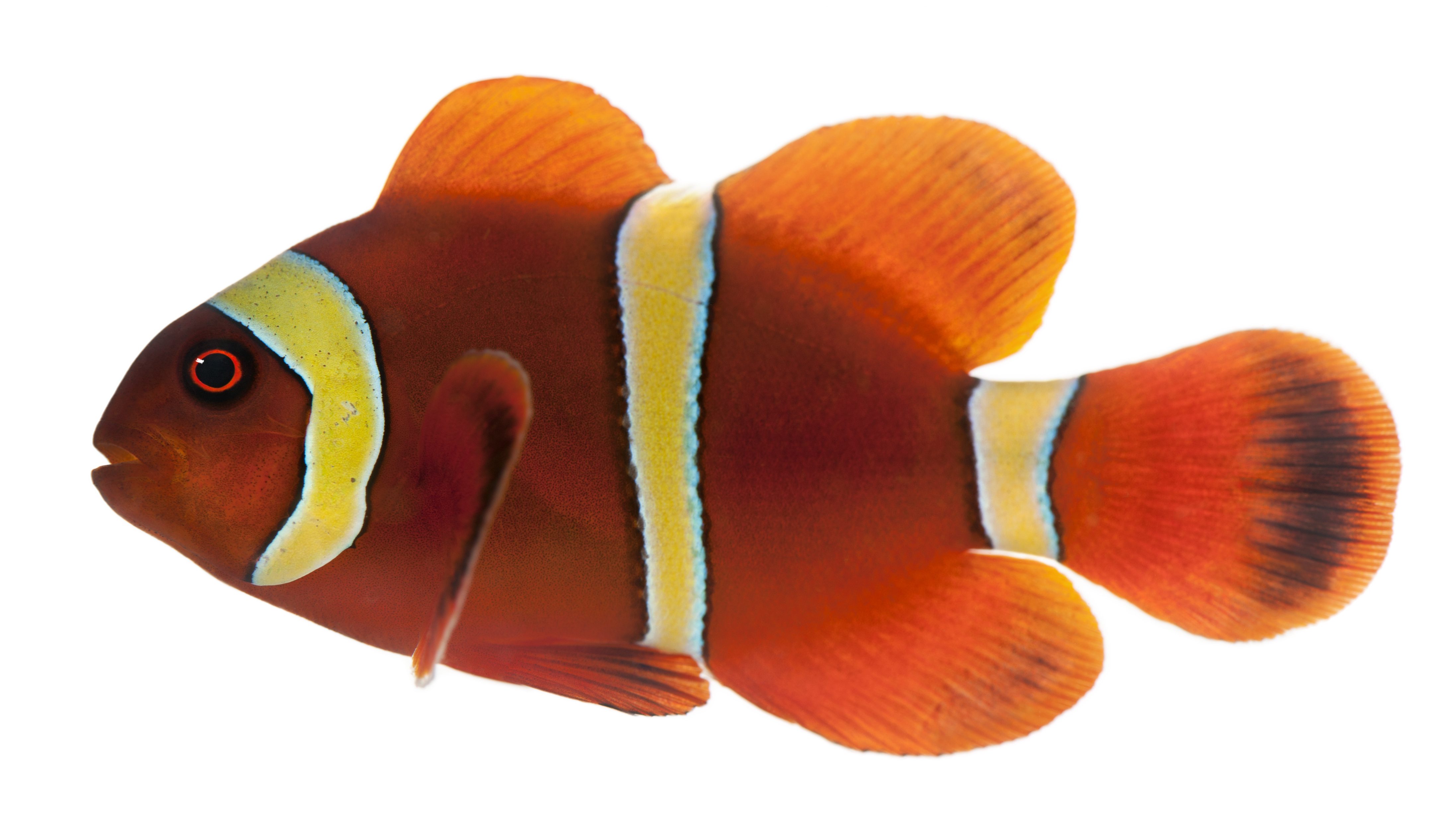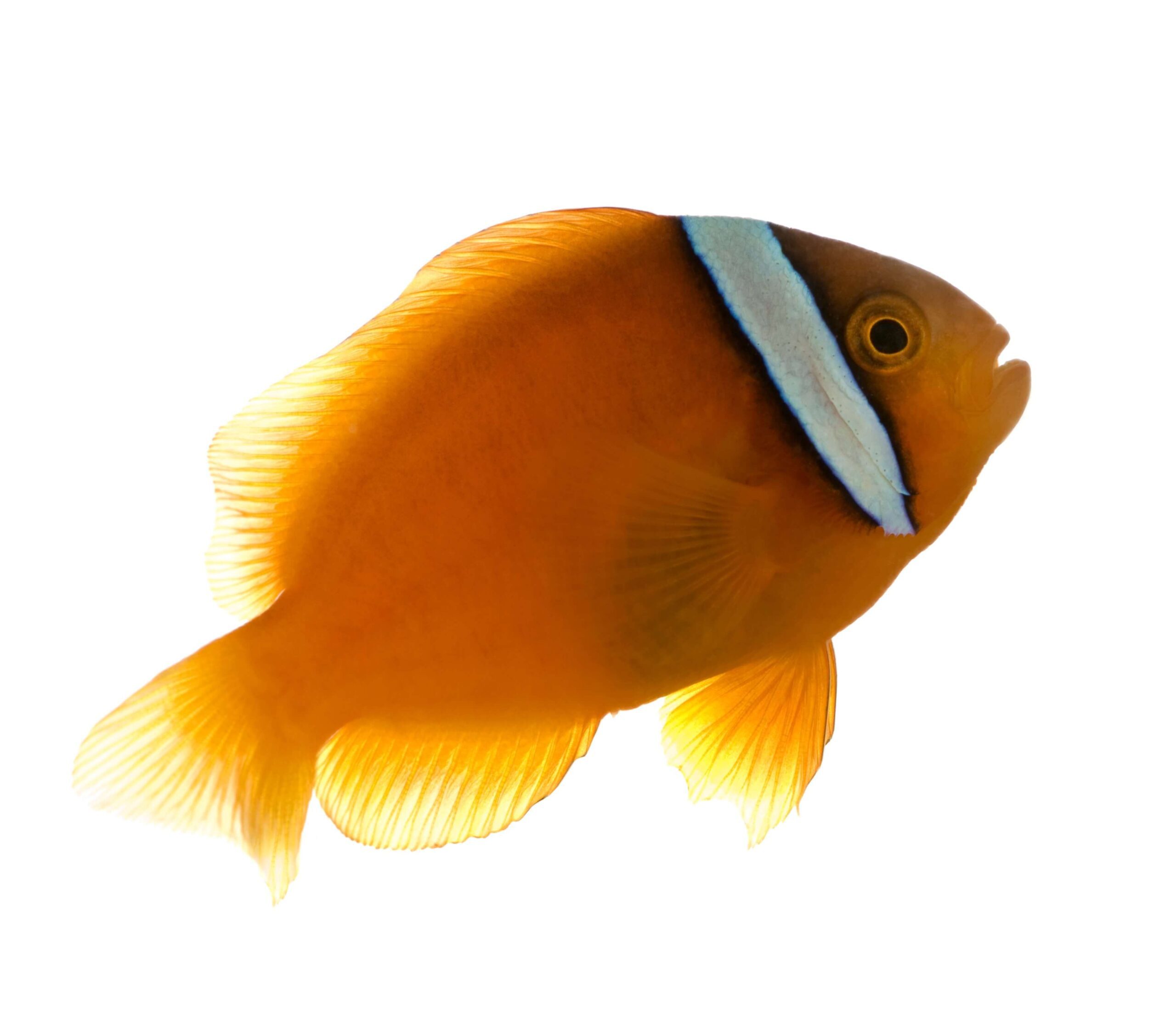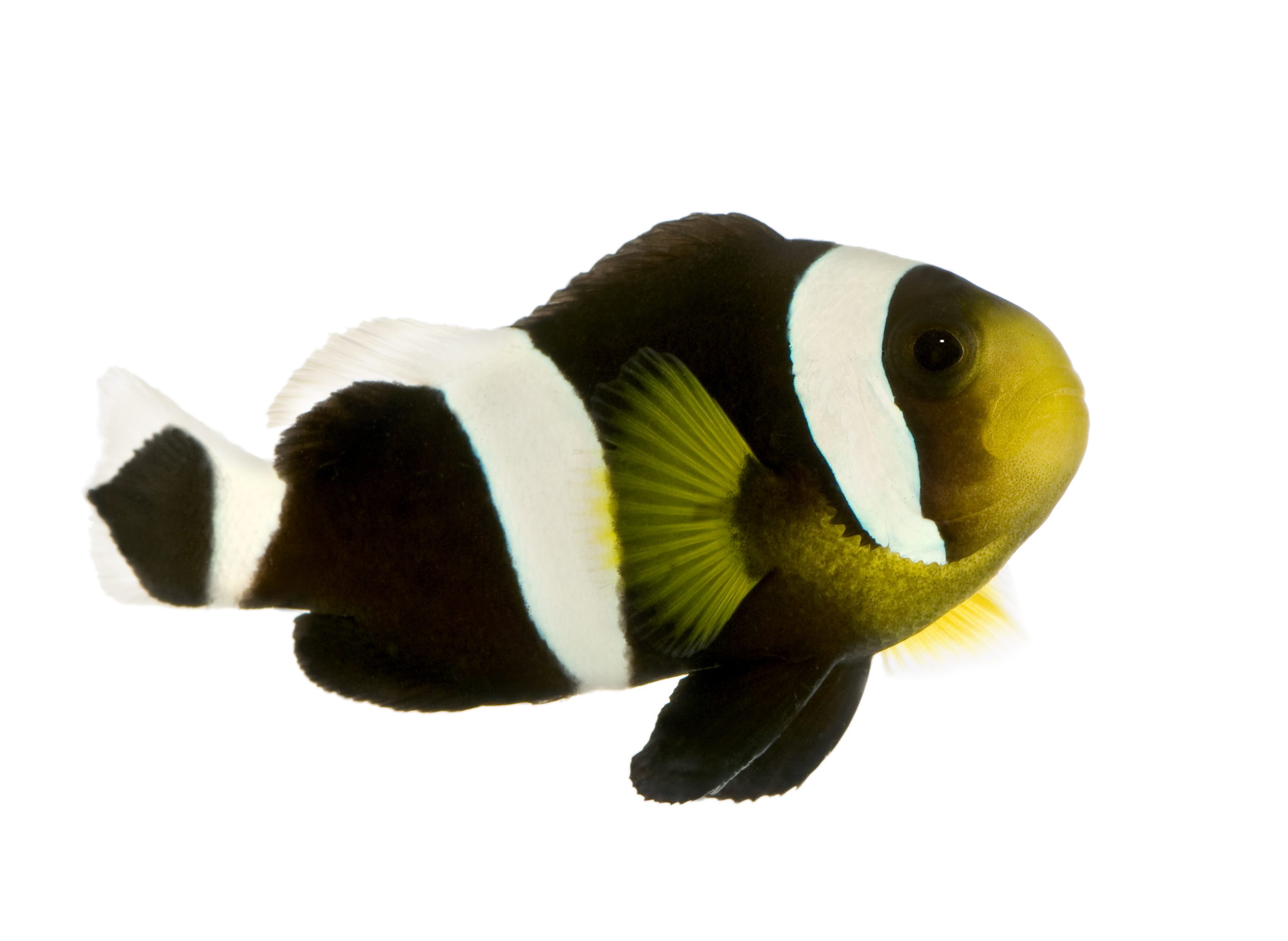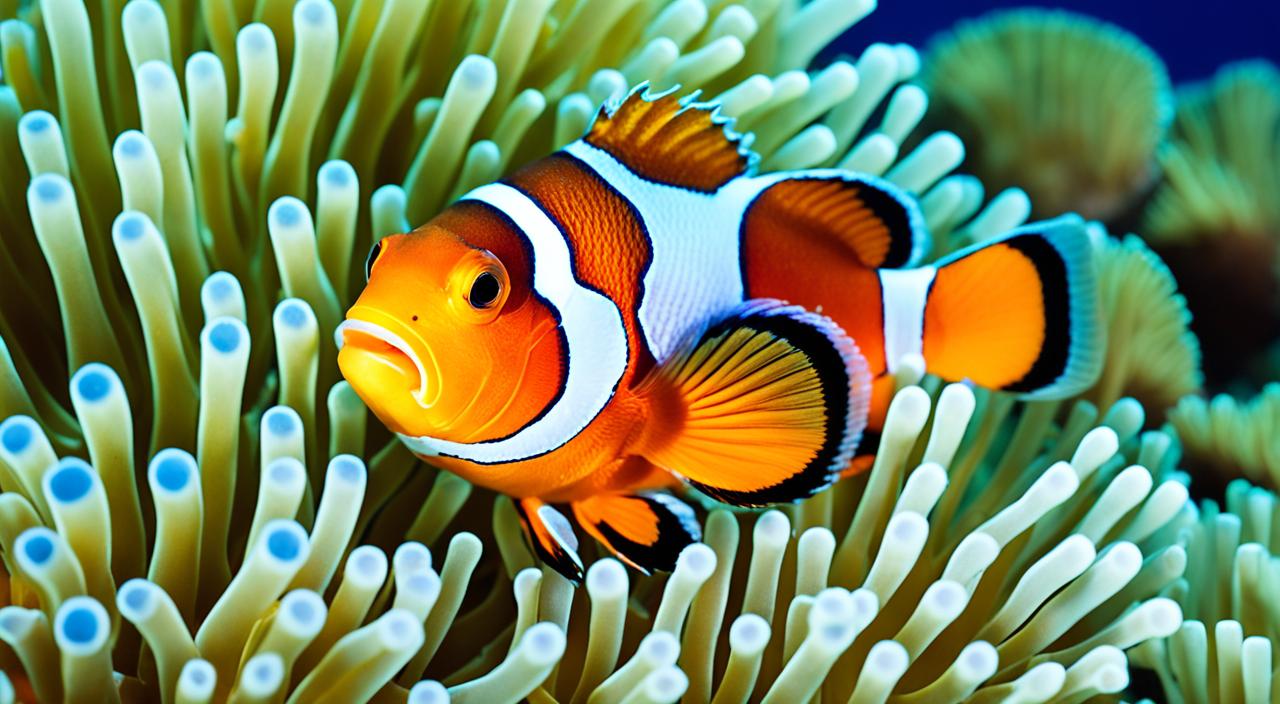Welcome to my comprehensive guide on the Maroon Clownfish, scientifically known as Premnas biaculeatus. This popular marine species is loved by aquarium enthusiasts for its vibrant colours and unique characteristics. Whether you’re a beginner or an experienced fish keeper, this article will provide valuable care tips for this stunning fish.
Maroon Clownfish, or Premnas biaculeatus, is a marine species that captures attention with its vibrant colours and distinctive characteristics. These beautiful fish are popular with aquarium enthusiasts due to their striking appearance and exciting behaviour. This article will explore the taxonomy, natural habitat, physical description, behaviour, aquarium requirements, diet and feeding, and breeding and reproduction of the Maroon Clownfish.
Key Takeaways:
- The Maroon Clownfish, or Premnas biaculeatus, is a popular marine species among aquarium enthusiasts.
- It is known for its vibrant colours and unique characteristics.
- This comprehensive guide will provide care tips to maintain the Maroon Clownfish in your aquarium successfully.
- Understanding the Maroon Clownfish’s taxonomy, natural habitat, and behaviour is crucial for its well-being in captivity.
- This article will discuss proper diet, suitable tank mates, and breeding considerations.
Introduction
Welcome to the captivating world of Maroon Clownfish! This section will provide an overview of this mesmerizing marine species. Maroon Clownfish, scientifically known as Premnas biaculeatus, are highly sought-after by aquarium enthusiasts for their vibrant colours and unique characteristics. They have gained popularity not only for their stunning appearance but also for their significance in the marine ecosystem.
Maroon Clownfish are known for their distinctive features, such as bold red or maroon colouration with contrasting white stripes and a spine on their cheek. Their striking appearance makes them a visually appealing addition to home aquariums.
Additionally, Maroon Clownfish holds cultural significance, mainly due to its association with the popular animated movie Finding Nemo. The film showcased the beauty and allure of Maroon Clownfish, further increasing their demand among fish keepers.
Taxonomy and Classification
This section will delve into the taxonomy and classification of the Maroon Clownfish. Understanding the taxonomy of a species provides valuable insights into its evolutionary history and relationships with other related species. The Maroon Clownfish, scientifically known as Premnas biaculeatus, can be classified as follows:
- Kingdom: Animalia
- Phylum: Chordata
- Class: Actinopterygii
- Order: Perciformes
- Family: Pomacentridae
- Subfamily: Amphiprioninae
- Genus: Premnas
- Species: biaculeatus
By examining the Maroon Clownfish’s taxonomic classification, we can better understand its place within the animal kingdom and its relationships with other fish species. Now, let’s look at its natural habitat and distribution.
Natural Habitat and Distribution
The Maroon Clownfish (Premnas biaculeatus) is native to the warm waters of the Indo-Pacific region. It is found in the natural habitat of coral reefs, explicitly preferring anemones as its primary shelter. These anemones provide protection and symbiotic benefits to the Maroon Clownfish, creating a mutually beneficial relationship. The fish seek refuge within the anemone’s stinging tentacles while the anemone gains protection from predators through the fish’s presence.
The Maroon Clownfish is distributed across a wide range, including the waters of the Red Sea, Indian Ocean, and Pacific Ocean. It can be found in countries such as Indonesia, Malaysia, the Philippines, Papua New Guinea, Australia, and Fiji. Within these regions, the Maroon Clownfish inhabits various reefs, including fringing reefs, barrier reefs, and atoll reefs.
In the wild, the Maroon Clownfish prefers rocky or coral-filled areas with access to shelter and ample food sources. It can be found at depths ranging from shallow lagoons to deeper reef slopes. The distribution of Maroon Clownfish populations is influenced by factors such as water temperature, salinity, and availability of suitable host anemones.
Understanding the natural habitat and distribution of the Maroon Clownfish is vital when recreating its environment in captivity. Aquarists can ensure the well-being and optimal health of these captivating fish in their home aquariums by providing a suitable habitat that mimics its natural surroundings.
Physical Description and Characteristics
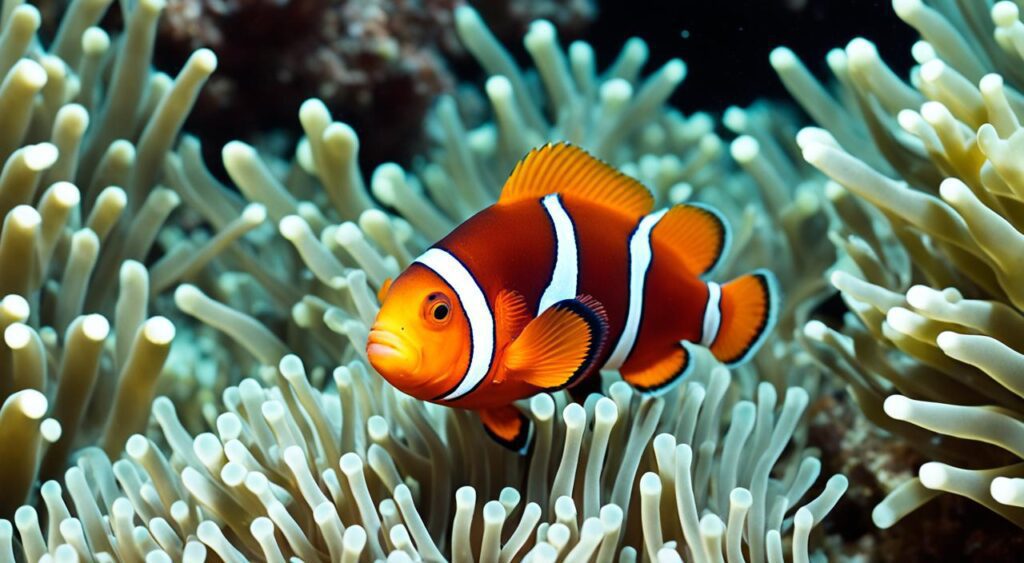
The Maroon Clownfish, or Premnas biaculeatus, is a visually striking fish with unique physical features. It has a medium-sized body, typically reaching a length of about 6 inches (15 centimetres) when fully grown. The Maroon Clownfish has a deep, compressed shape, with a high back and a rounded belly.
One of the Maroon Clownfish’s most distinctive characteristics is the prominent spine on each cheek. These sharp spines can inflict injuries, serving as a defence mechanism against potential predators. The colouration of the Maroon Clownfish varies depending on its gender and geographic location.
Female Maroon Clownfish usually have a vibrant red or maroon body, hence the name. They may also display vertical or irregular black bands, enhancing their striking appearance. On the other hand, Male Maroon Clownfish has a more muted colouration, often featuring a reddish-brown or dark-brown body with fewer or no black bands.
The Maroon Clownfish is a highly sought-after species in the aquarium trade due to its striking colours and unique physical attributes. Its captivating appearance adds vibrancy and charm to any marine tank, making it a popular choice among aquarium enthusiasts.
Behaviour and Temperament
To provide the best care for Maroon Clownfish in captivity, it is essential to understand their behaviour and temperament. These factors are crucial in creating a harmonious and stress-free environment for these beautiful fish.
Maroon Clownfish are known for their unique social structure and fascinating mating rituals. They form hierarchical groups consisting of a dominant female, a breeding male, and various subordinate males. This social hierarchy is maintained through aggressive behaviour and elaborate displays, such as chasing and fin flaring. Understanding and respecting their social structure is essential to maintaining a peaceful aquarium.
Regarding territorial behaviour, Maroon Clownfish are highly protective of their chosen anemone, home, and refuge. They will vigorously defend their territory against intruding fish and invertebrates. It is essential to provide ample hiding places and suitable anemones to prevent conflicts and ensure the well-being of the Maroon Clownfish.
Regarding interactions with other fish and invertebrates, Maroon Clownfish generally have a moderate temperament. They can coexist with various tank mates, especially if introduced to the aquarium simultaneously. However, caution should be exercised when adding potentially aggressive species that may harm or outcompete the Maroon Clownfish.
Overall, understanding the behaviour and temperament of Maroon Clownfish is essential for maintaining a thriving aquarium. By creating an environment that accommodates their social structure, supports territorial behaviours, and fosters peaceful interactions with other tank inhabitants, you can ensure the well-being and happiness of your Maroon Clownfish.
Aquarium Requirements
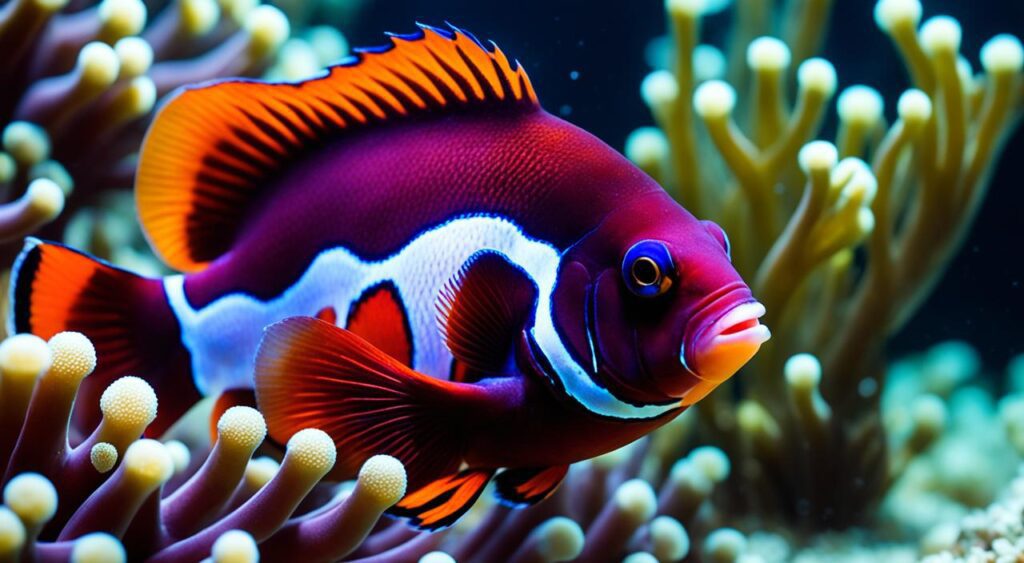
To ensure the health and well-being of your Maroon Clownfish, it is crucial to provide them with the appropriate aquarium conditions. This section will discuss the ideal tank size and layout, water parameters, suitable tank mates, and compatibility with live plants and invertebrates.
Ideal Tank Size and Layout
The tank size for Maroon Clownfish will depend on the number of fish you plan to keep. Generally, a minimum tank size of 30 gallons is recommended for a single Maroon Clownfish. However, if you plan to keep a pair or a small group, a larger tank of 50 gallons or more is preferable to ensure enough space for each fish to establish their territory.
The layout of the tank should include plenty of hiding places, such as live rock formations, caves, and coral structures. These hiding spots will help security for the Maroon Clownfish to mimic their natural habitat and reduce stress.
Water Parameters
Maintaining optimal water parameters is essential to promote your Maroon Clownfish’s health and vitality. The ideal temperature range for Maroon Clownfish is 74-78°F (23-25.5°C), and the pH level should be kept between 8.1 and 8.4. A salinity level of 1.023-1.026 (specific gravity) is also recommended.
Regular monitoring of ammonia, nitrite, and nitrate levels is crucial to ensure a stable and healthy environment for the fish. Weekly 10-20% water changes will help maintain water quality and remove accumulated waste products.
Suitable Tank Mates and Potential Conflicts
When selecting tank mates for Maroon Clownfish, it is essential to consider their compatibility. They generally get along well with peaceful and non-aggressive species, such as gobies, blennies, and tangs. However, it is best to avoid housing them with aggressive or territorial fish, as they may become targets of aggression.
It is also essential to observe the behaviour of your Maroon Clownfish when introducing new tank mates. Sometimes, they may exhibit territorial behaviour and defend their preferred hiding spots. Providing sufficient hiding places and establishing territories through structures like stacked rock formations can help minimize conflicts.
Compatibility with Live Plants and Invertebrates
Maroon Clownfish are generally compatible with live plants, but caution should be exercised when selecting plant species. Hardy, saltwater-tolerant plants, such as macroalgae and certain seagrass species, can be suitable options as they add beauty and natural filtration to the aquarium.
Regarding invertebrates, Maroon Clownfish can coexist with various species, including cleaner shrimp, hermit crabs, and snails. However, caution should be exercised when housing them with more delicate invertebrates, such as anemones or soft corals, as they may show signs of aggression towards these organisms.
By adhering to these aquarium requirements, you can create a suitable and thriving environment for your Maroon Clownfish, ensuring their health, happiness, and longevity.
Diet and Feeding
Dietary Preferences
The Maroon Clownfish has specific dietary preferences to consider when providing their meals. They primarily feed on small invertebrates such as copepods, amphipods, and small shrimps in their natural habitat. They may also consume algae and organic debris in their surroundings.
In captivity, it is essential to replicate their natural diet as closely as possible to ensure their optimal health and well-being. You can meet their nutritional needs and mimic their natural feeding behaviours by offering a varied diet that includes both live and prepared foods.
Recommended Foods and Feeding Schedule
When feeding Maroon Clownfish, a combination of live and prepared foods is recommended. Live foods such as brine shrimp, mysis shrimp, and copepods can provide them with essential nutrients and promote their natural foraging instincts.
In addition to live foods, prepared foods specifically formulated for marine fish can be included in their diet. These foods are available as flakes, pellets, or frozen options and offer a convenient and nutritious alternative to live foods.
It is essential to establish a regular feeding schedule for Maroon Clownfish. They should be fed small amounts two to three times daily, ensuring they consume their meals within a few minutes. Overfeeding should be avoided to prevent water quality issues and obesity.
Tips on Ensuring a Balanced and Nutritious Diet
To ensure a balanced and nutritious diet for your Maroon Clownfish, consider the following tips:
- Offer a variety of foods: Providing a diverse range will help meet their nutritional needs and prevent dietary deficiencies. Include live, frozen, and prepared foods with different textures and flavours.
- Supplement with vitamins and minerals: As some prepared foods may lack certain essential nutrients, consider supplementing their diet with vitamin and mineral supplements specifically designed for marine fish.
- Observe their feeding behaviour: Pay attention to how your Maroon Clownfish interact with different types of food. This can help you determine their preferences and adjust their diet accordingly.
- Maintain good water quality: Proper filtration and regular water changes are essential for keeping the water clean and free from contaminants, which can impact the health and appetite of your Maroon Clownfish.
Following these tips and providing a well-rounded diet ensures that your Maroon Clownfish remains healthy and thriving in your aquarium.
Breeding and Reproduction
In this final section, I will provide valuable insights into the breeding and reproduction process of maroon clownfish. Understanding the breeding behaviour and creating suitable conditions are essential for successful reproduction in captivity.
Breeding Behavior and Conditions
Maroon Clownfish exhibit interesting breeding behaviours. The male and female form monogamous pairs and establish a hierarchy within the group. The dominant female is the largest and transforms into a male if the male dies or is removed. During courtship, the pair performs an elaborate dance involving rubbing against each other and swimming close together. This behaviour stimulates the release of eggs by the female, followed by the male’s fertilization.
To encourage breeding, provide your Maroon Clownfish with a well-established and appropriate environment. Maintain the tank temperature between 75°F and 82°F (24°C to 28°C) and ensure stable water quality. Good water flow and clean, premium-quality saltwater are essential. Creating hiding places using live rock and providing ample lighting mimics their natural habitat conditions, promoting their comfort and breeding instincts.
Care of Eggs and Fry
Once the eggs are fertilized, the male takes on the role of caring for them. He defends and ventilates the eggs by fanning them with his fins to ensure proper oxygenation. The eggs typically hatch within 8 to 12 days, depending on water temperature. Once the fry emerges, they will continue to receive parental care and remain in close proximity to the anemone host, where they find protection. Provide nutritious live or frozen foods, such as rotifers and newly hatched brine shrimp, to satisfy their small size and dietary requirements.
Challenges in Breeding in Captivity
Breeding Maroon Clownfish in captivity can present a few challenges. It can take time for the pairs to establish their hierarchy and initiate breeding behaviours. Patience and a well-maintained aquarium environment are crucial. Additionally, ensuring a successful transition from being a female to a male in the absence of the original male can be challenging. It is advisable to consult with experienced breeders or specialists for guidance in managing this complex process.
In conclusion, understanding the breeding behaviour, providing suitable conditions, and offering proper care for the eggs and fry are essential to successfully breeding Maroon Clownfish in captivity. Despite the challenges, witnessing the entire process is a rewarding experience for any dedicated aquarium enthusiast.
FAQ
What is the Maroon Clownfish?
The Maroon Clownfish, scientifically known as Premnas biaculeatus, is a popular marine species known for its vibrant colors and unique characteristics.
Where can I find the Maroon Clownfish in the wild?
The Maroon Clownfish can be found in the wild in various geographical regions, typically inhabiting reefs and structures.
What are the physical characteristics of the Maroon Clownfish?
The Maroon Clownfish is known for its distinctive colors and features, such as a spine on its cheek, which make it easily identifiable.
How does the Maroon Clownfish behave in an aquarium setting?
The Maroon Clownfish has a unique social structure and territorial behavior, which should be considered when keeping them in an aquarium.
What are the ideal aquarium requirements for the Maroon Clownfish?
The Maroon Clownfish requires specific tank size, layout, water parameters, suitable tank mates, and compatibility with live plants and invertebrates.
What should I feed my Maroon Clownfish?
The Maroon Clownfish has specific dietary preferences and feeding habits that should be catered to for a balanced and nutritious diet.
How can I breed and reproduce Maroon Clownfish in a home aquarium?
Breeding Maroon Clownfish requires an understanding of their breeding behavior and specific conditions, as well as care for the eggs and fry.
What are the challenges in breeding Maroon Clownfish in captivity?
Breeding Maroon Clownfish in a home aquarium can present challenges, but with proper knowledge and care, these obstacles can be overcome.

